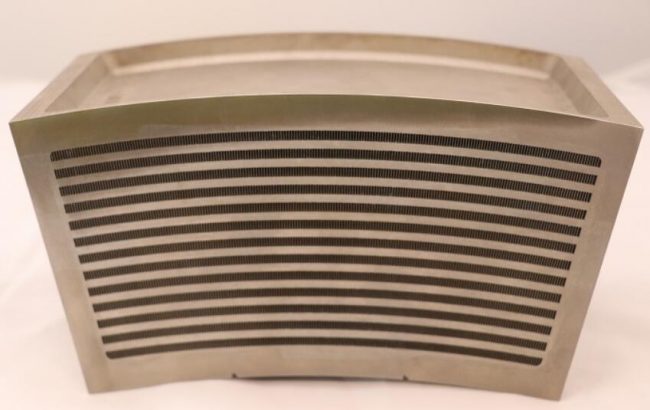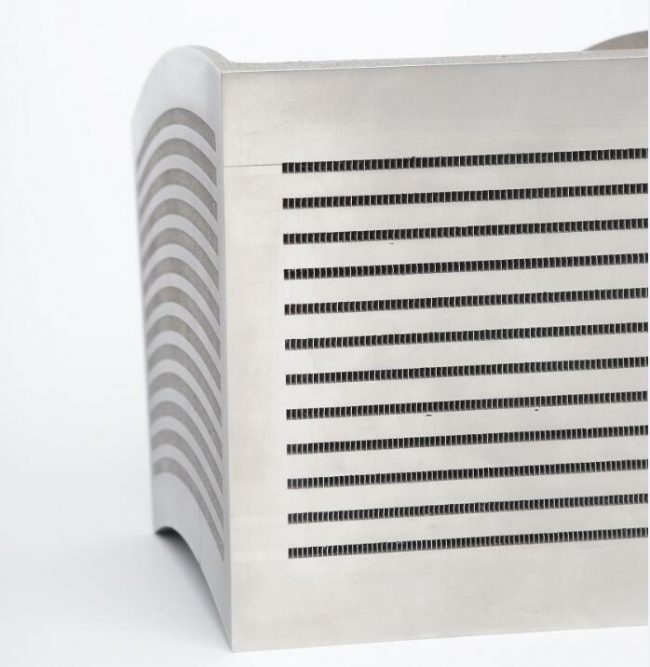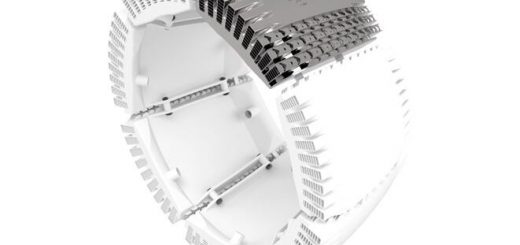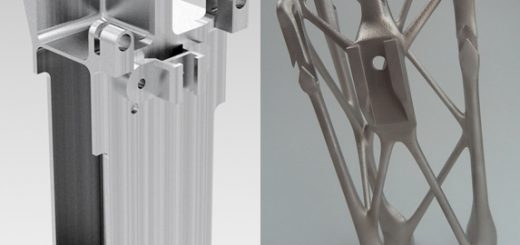High-Performance, 3D-Printed Heat Exchangers Cool Aircraft Engines
Temperatures in modern jet engines and aircraft subsystems are heating up. Electronics packages are performing more tasks and powering larger engines. Cooling is critical.Heat exchangers, key to lowering an engine’s thermostatic readings, have been given the unique challenge of handling the increasingly aggressive heat removal requirements. They need to incorporate higher heat transfer properties while simultaneously fitting into smaller spaces.
 A nickel superalloy AM plate-fin heat exchanger exceeds conventional heat exchanger performance.
A nickel superalloy AM plate-fin heat exchanger exceeds conventional heat exchanger performance.
United Technologies Corp. (UTC), in conjunction with America Makes, the U.S. Department of Defense, and UTC’s Additive Manufacturing Center of Expertise (AMCoE) has been using additive manufacturing (AM) to design and build heat exchangers that are more efficient, more compact, and more reliable than those produced with traditional manufacturing methods. Other project participants include Stratonics, 3DSIM, 3rd Dimension, University of Connecticut, and two UTC business units—Collins Aerospace and Pratt & Whitney.
Venkat Vedula, executive director, AMCoE, UTC, discussed the project’s conformal fan duct heat exchangers for engine thermal management systems, the successes thus far, and the future of AM with The Additive Report.
The Additive Report: Why is the AM process important to aerospace and the next generation of heat exchangers?
Venkat Vedula: Finding the right thermal management systems is one of the key challenges as aircrafts become more sophisticated in efforts to increase their range and improve systems performance. Aircrafts are operating at higher temperatures and the heat needs to be extracted effectively. At the same time, heat exchangers need to be more efficient and more compact while meeting performance requirements in confined spaces. AM, or 3D printing, has been applied to a variety of parts—whether brackets, housings, or heat exchangers—to balance the design aspects needed when meeting both new performance and size requirements.
AR: How do AM technologies help in the approach to the double challenge of increasing efficiencies and reducing size?
Vedula: Most of today’s heat exchangers have either rectilinear shaped designs, rectangular with some depth, or tube shell designs. It can be very challenging to find space for these shapes within an aircraft system. Their configurations can impact efficiency and add weight due to transition regions between linear or circular heat exchanger core segments.
The AM process doesn’t incorporate the limitations of traditional manufacturing technologies so heat exchanger design complexity comes free. Using AM we have the freedom to develop conformal shapes with novel heat exchanger topologies, improve specific heat transfer capacity and process yields, and reduce overall specific fuel consumption. We started with a clean piece of paper, a list of requirements, and said, “What is the best way for us to make this happen?” That freedom allowed us to come up with truly organic designs that are more efficient in heat transfer effectiveness and can fit tight spaces. AM-constructed heat exchangers with conformal shapes can utilize available space that is close to the engine.
Reducing weight is always important in aircraft systems but, in some cases, reducing size is more important. In this program both size and weight have been reduced by about 20 percent compared to the current best-in-class heat exchangers. By integrating headers and utilizing innovative topologies for heat transfer, size and weight can be further reduced.
AR: Does AM bring other benefits to the heat exchanger production process?
 A cross-flow heat exchanger design uses thin fins and parting sheets.
A cross-flow heat exchanger design uses thin fins and parting sheets.
Vedula: There are several manufacturing operations including forming, brazing and welding involved in the conventional manufacturing of heat exchangers. Using additive, all of these operations are eliminated.
An AM part is built in one operation so there are no seams or joints that could develop leaks. Process variability is eliminated and overall quality is expected to be much higher.
AR: What type of AM process do you use and what materials are involved?Vedula: Powder bed fusion (PBF) is the process we have worked with for the heat exchangers. The team used physics-based process models for defect prediction and in-process monitoring techniques.
Materials are primarily nickel-based alloys like INCONEL® 625 and 718 plus some advanced aluminum alloys. Some recently developed aluminum alloys are almost as good as today’s proven aerospace alloys.
AR: How does the physics-based process work with this project?
Vedula: A PBF machine typically has hundreds of set parameters such as laser power, scan speed, and layer height that all tie back to the quality of the part. In general, the default machine parameters are good for making dense brackets and such, but not for producing a heat exchanger with all of the internal, complex features we want. Recognizing that minimizing pressure drop while maximizing exchanger metrics requires control of fin and parting sheet thicknesses and surface roughness, the primary focus was on printing the thinnest, smoothest possible, defect-free fins and parting sheets to achieve the heat exchanger metrics. The complex geometries and internal channels of the conformal heat exchangers require these very thin parts to be printed without support structures because there is no access to physically remove supports.
We changed the printing parameters and used physics-based models to gain a fundamental understanding of the PBF process itself. The science behind understanding the linkages between the laser scan vectors and local thermal history helped us tailor the scan strategies to achieve the elements we want.
Developing that understanding is what really helped us build a conformal heat exchanger with thin fins at different orientations, with different geometries, and without using support structures.
It was truly a combination of design methodology and an understanding of the process that helped us meet top-level performance requirements.
AR: Some heat exchanger features need to be thicker than the fins. How are variances handled during the build?
Vedula: We look at the heat exchangers conceptually and divide the geometry into key features. There are sections outside of the core that have dense geometries similar to brackets. Within the core you can have top-facing and down-facing surfaces.
For each of the different design features we identified the optimal combination of parameters to get really good microstructure and material properties.
AR: What, if any, finishing is required?
Vedula: Ordinarily it is just the post-thermal treatment to relieve stresses. All of the parts we build go through stress relief and HIP [hot isostatic pressing]. The fins don’t require finishing.
AR: Is the aircraft industry ready to accept AM conformal heat exchangers?
Vedula: In the AM industry we are essentially throwing out the heat exchanger design rule book that is decades old, while retaining the decades of experience. There is strong pull for conformal heat exchangers from our customers due to reduction in part size and weight as well as the elimination of joining steps.
We are working with customers to demonstrate the quality and process consistency as well as performance. In-situ process monitoring using optical and thermal imaging techniques is advancing, building confidence in the process itself, and reducing concerns for part-to-part and machine-to-machine variations.
Effectively, utilizing AM technology also requires a culture shift. Part of our mission at AMCoE is to bring in design and manufacturing engineers to help them gain an understanding through our training curriculum that highlights the benefits of the technology, its challenges, and the new design rules.
AR: What is next based on information gleaned from this project?
Vedula: The design tool chain and methodology need to evolve quickly to fully utilize the design flexibility offered by AM. There has been significant progress made by tool chain providers in the last year and we expect integrated tools to be available next year. We anticipate that it will take four to five years for AM technology to expand to include all types of heat exchangers.
For aircraft industry replacement parts, depending on the part itself, AM is already serving in some MRO [maintenance, repair, and overhaul] shops. As long as the performance requirements and design intent can be met, we see this as a huge area of opportunity.This particular project has demonstrated the importance of AM technology itself and the importance of having a fundamental understanding of the process. When a well-trained and creative team like ours has both, it can advance the technology to meet and exceed part performance goals. This project has also demonstrated the value of breaking a given complex part geometry into key design features and assigning specific build orientations, scan strategies, and process parameters to each feature.
The approach developed on this project is scalable to other part families.
Source:The Addictive Report




Recent Comments